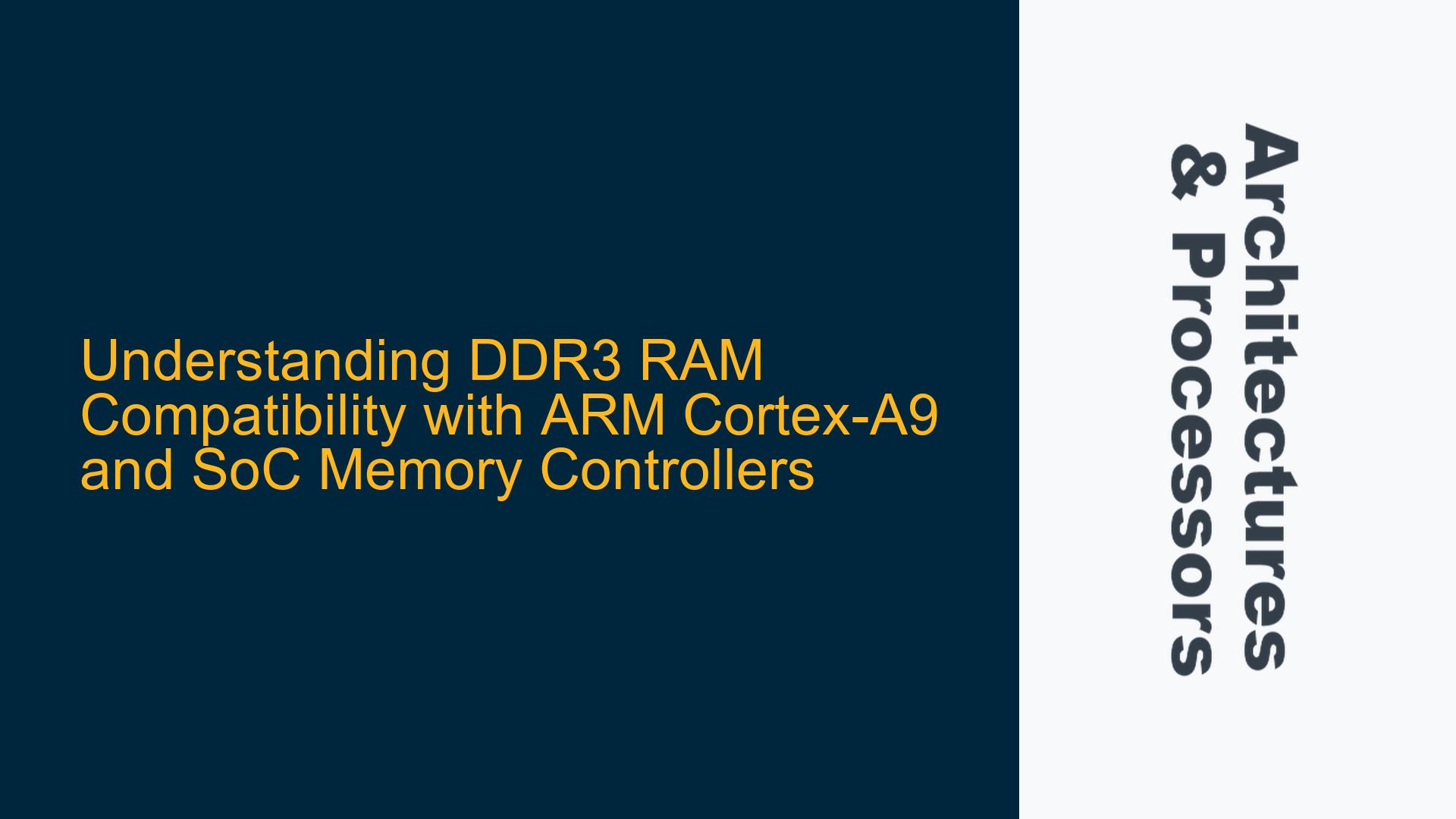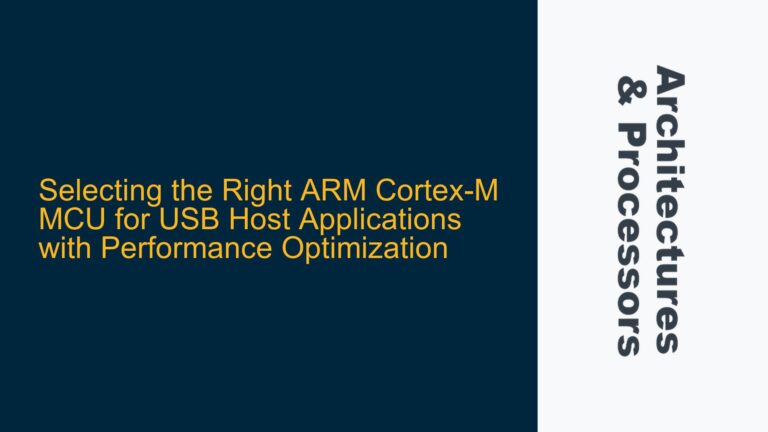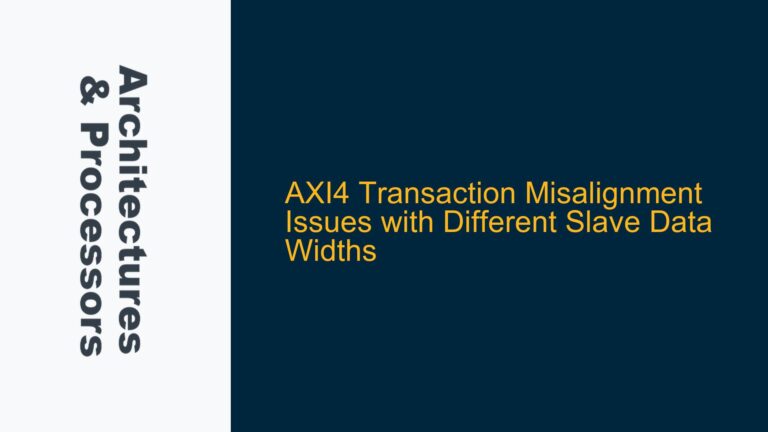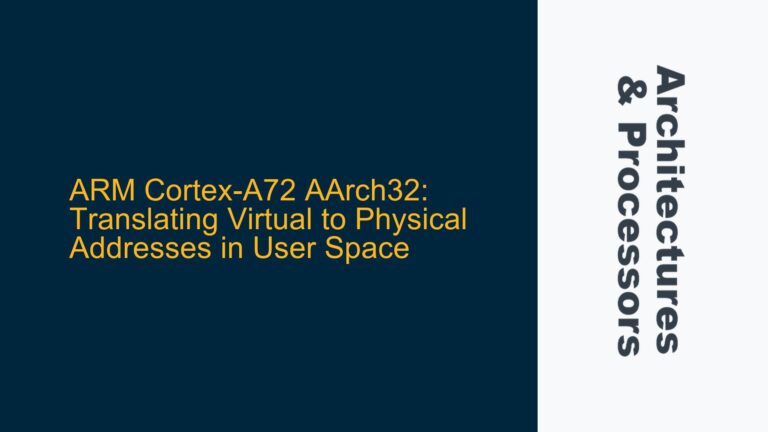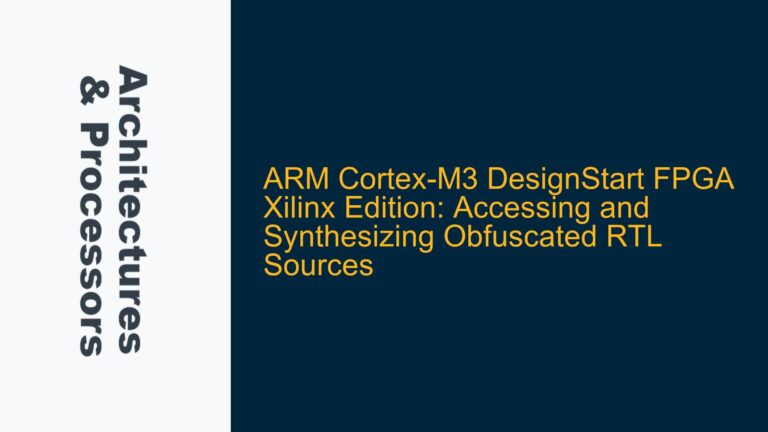DDR3 RAM Compatibility with ARM Cortex-A9 and Memory Controller Integration
The compatibility of DDR3 RAM with an ARM Cortex-A9 processor or any ARMv7-A architecture-based system is not a direct relationship between the processor core and the memory itself. Instead, it is mediated by the memory controller integrated within the System on Chip (SoC). The ARM Cortex-A9 core communicates with external DDR3 RAM through this memory controller, which handles the low-level signaling and protocol requirements of the DDR3 standard.
The DDR3 memory controller is responsible for managing the timing, addressing, and data transfer between the processor and the RAM. It ensures that the memory operations comply with the JEDEC JESD79-3D standard for DDR3 SDRAM. Therefore, the compatibility of DDR3 RAM with an ARM Cortex-A9-based system depends on whether the SoC’s memory controller supports the specific DDR3 RAM in question.
For example, the i.MX 6Dual/6Quad SoC from NXP features a Multi-Mode DDR Controller (MMDC) that supports DDR3 memory compliant with the JESD79-3D standard. The MMDC can interface with DDR3 RAM chips of varying bus widths (x16, x32, and x64) by combining multiple memory chips or ranks. This flexibility allows the SoC to support a wide range of DDR3 configurations, even though individual DDR3 chips typically have a maximum bus width of x16 bits.
Memory Bus Width and Rank Configuration in DDR3 Systems
The bus width of DDR3 RAM is a critical factor in determining compatibility with an SoC’s memory controller. According to the JESD79-3D standard, DDR3 chips are available in x4, x8, and x16 configurations, meaning the data bus width for a single chip is 4, 8, or 16 bits, respectively. However, modern SoCs like the i.MX 6Dual/6Quad support wider bus widths (x32 and x64) by combining multiple DDR3 chips into ranks.
A rank is a set of DDR3 chips that share the same chip select signal and are accessed simultaneously. Each rank provides a 64-bit data bus, which is the standard width for DDR3 memory modules. For example, a rank of x8 DDR3 chips would consist of eight chips (or nine if Error Correction Code (ECC) is supported), while a rank of x4 chips would require 16 chips (or 18 with ECC). By combining ranks, the memory controller can achieve wider bus widths. For instance, a dual-rank configuration with x16 chips would provide a 32-bit bus width, and a quad-rank configuration would provide a 64-bit bus width.
The i.MX 6Dual/6Quad’s MMDC supports these configurations, enabling it to interface with DDR3 memory modules that have bus widths of 32 or 64 bits. This is achieved by using multiple ranks of x16 DDR3 chips. The MMDC also supports high-speed operation, with a maximum frequency of 532 MHz for DDR3 memory, ensuring optimal performance for the ARM Cortex-A9 processor.
Addressing Memory Organization and Translation in ARMv7-A Architecture
The ARMv7-A architecture uses a memory management unit (MMU) to translate virtual addresses to physical addresses. This translation is based on a hierarchical page table structure, which organizes memory into sections, large pages, and small pages. Sections are 1 MB blocks of memory, large pages are 64 KB blocks, and small pages are 4 KB blocks. This organization is independent of the physical memory technology (e.g., DDR3 RAM) and is managed entirely by the MMU.
The page size of DDR3 RAM, as specified in the datasheets of Alliance Memory (AS4C128M16D3B-12BCN) and ISSI (IS43/46TR82560B), refers to the internal organization of the memory array within the chip. For example, the Alliance Memory DDR3 chip has a page size of 1 KB for x8 configurations and 2 KB for x16 configurations, while the ISSI chip has a page size of 1 KB. These page sizes are unrelated to the MMU’s page table organization and do not affect the compatibility of the RAM with the ARMv7-A architecture.
The MMU’s translation tables are stored in main memory (DDR3 RAM) and are used by the processor to map virtual addresses to physical addresses. The DDR3 RAM’s page size does not constrain the MMU’s ability to organize memory into 1 MB sections, 64 KB large pages, or 4 KB small pages. Therefore, the DDR3 RAM’s page size is irrelevant to the ARMv7-A architecture’s memory translation mechanism.
Troubleshooting DDR3 RAM Compatibility and Configuration Issues
When integrating DDR3 RAM with an ARM Cortex-A9-based system, several factors must be considered to ensure compatibility and optimal performance. These include the memory controller’s supported bus widths, the DDR3 RAM’s specifications, and the system’s memory organization.
Verifying Memory Controller Support for DDR3 RAM
The first step in troubleshooting DDR3 RAM compatibility is to verify that the SoC’s memory controller supports the specific DDR3 RAM being used. This involves checking the memory controller’s datasheet or reference manual for details on supported DDR3 standards, bus widths, and configurations. For example, the i.MX 6Dual/6Quad’s MMDC supports DDR3 memory compliant with the JESD79-3D standard and can interface with DDR3 chips of x16, x32, and x64 bus widths.
Configuring Memory Ranks and Bus Widths
If the memory controller supports wider bus widths than the individual DDR3 chips, the system must be configured to use multiple ranks of DDR3 chips. This requires careful design of the memory subsystem, including the layout of the DDR3 chips and the routing of the address, data, and control signals. The memory controller’s reference manual typically provides guidelines for configuring ranks and bus widths, as well as example schematics and layout recommendations.
Ensuring Proper Timing and Signal Integrity
DDR3 memory interfaces operate at high speeds and require precise timing and signal integrity to function correctly. The memory controller’s datasheet or reference manual should specify the timing parameters for DDR3 memory, including clock frequencies, setup and hold times, and signal termination requirements. These parameters must be matched to the DDR3 RAM’s specifications to ensure reliable operation.
Debugging Memory Translation and Organization Issues
If issues arise with memory translation or organization, the MMU’s configuration should be reviewed. This includes verifying the page table structure and ensuring that the translation tables are correctly populated and stored in DDR3 RAM. Debugging tools such as JTAG probes and memory analyzers can be used to inspect the MMU’s operation and identify any discrepancies between the virtual and physical address mappings.
Addressing MTBF and Reliability Concerns
The Mean Time Between Failures (MTBF) of DDR3 RAM is typically not specified in the datasheets of individual memory chips. Instead, it is determined by the overall design and manufacturing quality of the memory module. If reliability is a concern, it is recommended to use DDR3 RAM from reputable manufacturers and to follow best practices for memory subsystem design, including proper signal routing, power supply decoupling, and thermal management.
By following these troubleshooting steps and ensuring proper configuration of the memory controller, DDR3 RAM, and MMU, developers can achieve reliable and high-performance memory integration in ARM Cortex-A9-based systems.
